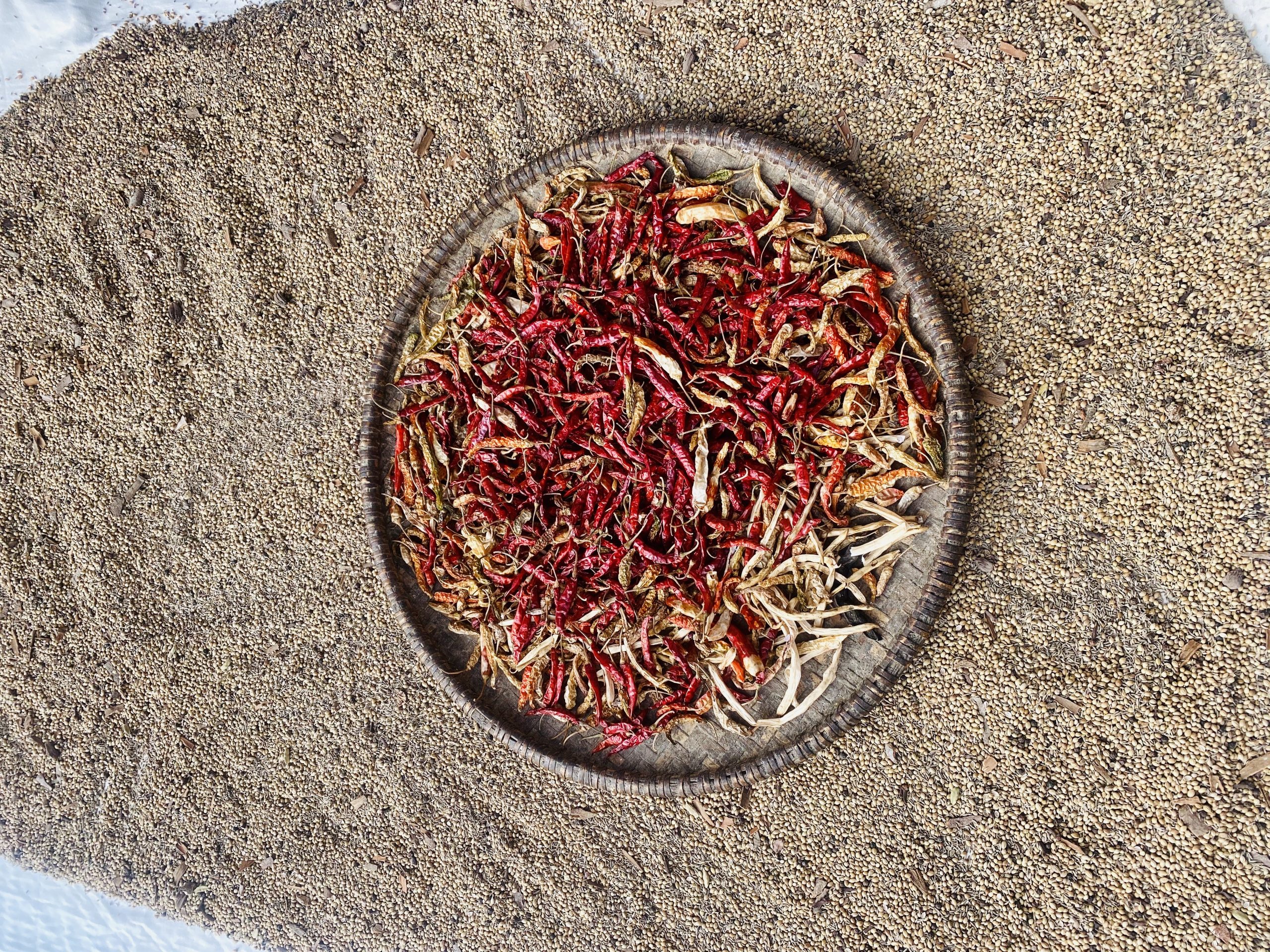- Aaratee Lamsal, Nepal Editor
Sangeeta was busy drying spices in the sun. She was preparing those spices for the biggest festival of Nepal, “Dashain.” Generally, people fond of meat prepare spices weeks before the festival. The spice includes Cumin Seed, Coriander seed, Clove, Cinamon, Black pepper (Marich), Black cardamom (alaichi), Green cardamom (sukmel), Betel nut (supari), Bay leaf (tej patta). But, the types of spices used vary according to the region and are found all over the country.
While asking about the importance, she told us that winter is approaching, and these spices save us from cold. One may limit the spice only to cumin seed and coriander seed in summer.
Besides these spices, Turmeric, Asafoetida, Green/Red Chillies, Fenugreek seeds, Thyme seeds, Garlic, Ginger, Red Pepper, etc…. are also used while making curry. Nepali Kitchen comprises these spices. Nepal has a quality of diverse and different cultures. Due to the diverse culture, Nepalese cuisine comprises varieties.

Sangeeta was explaining the procedure of cooking.
We pour some oil into a heated pan. Fenugreek seeds and Thyme seeds are spread in the oil. We don’t use much oil to make healthy dishes.
Fenugreek seeds are a feature in Nepali cuisines despite the bitter taste. These seeds also have a lot of health benefits. The seeds help remove body toxins and provide relief from a digestive disorder, indigestion, constipation, fever, cough, and sore throats. It reduces the risk of heart disease, control heart rate and blood pressure. They are a rich source of vitamins that helps to cure memory loss, Alzheimer’s disease, and early aging.
Similarly, Thyme seeds are used as a flavoring agent in food. It helps improve eyesight and keep bones healthy. Treats muscle cramps and helps control blood pressure. Thyme is an amazing herb that contains antibacterial and antifungal properties.

When the seeds become golden brown, we spread the turmeric powder and pour the curry in it. While making curry, turmeric powder is used to give the golden touch.
Turmeric is mandatory in Nepali Kitchen. A vibrant yellowish-orange color gives the dishes an attractive look instantly. This is why this principal spice is also known as the Golden spice. The use of turmeric is certainly a magic trick that is also preventing us from common seasonal cold since our childhood.
The New York Times claims that turmeric is effective in preventing high cholesterol, hay fever, depression, gingivitis, premenstrual syndrome, and even hangovers. Turmeric also helps to reduce inflammation and pain. It improves brain functions and fights various kinds of cancer like colorectal, breast, pancreatic, gastric, and prostate cancers.
We spread the salt, which helps to cook fast and brings the taste in the food. Nepalese cuisine uses sea salt, which is considered healthier than table salt.
Salt is usually a part of every meal and is almost used everywhere in the world. Salt stabilizes irregular heartbeats, regulates blood pressure, and prevents muscle cramps when used in a proper amount. It aids blood sugar control by improving insulin sensitivity. It also supports thyroid function.
Then after we spread the mixed spices and chili to our taste, garlic ginger paste is also added to give flavor.
Cumin helps with indigestion. It improves immunity. They are used to treat piles and insomnia. It also helps to cure anemia, skin disorders, boils, and even cancer. Cumin helps in treating asthma, so people having any respiratory disorders, add cumin to their diet. It also aids in treating asthma, bronchitis, and the common cold.

Ginger has anti-inflammatory properties that boost the immune system function by fighting infections. Ginger also counteracts chemical toxicities induced by industrial pollutants, alcohol, smoking. It helps to calm nausea and stomach pain. It purifies the blood. It may even lower the risk of heart disease, cancer, and diabetes.
They are scientifically known as Zingiber officinale can be consumed either in powder form or making a bowl of soup after boiling. It is a must ingredient in Nepali Curry. Dieticians say consuming just 2 grams of ginger powder every day can reduce blood sugar levels when fasting by around 12%. It can also make improvements of around 10% in the long term.
Garlic has been used for centuries in various societies to combat infectious diseases. Historically, it is believed that Louis Pasteur described the antibacterial effect of Garlic in 1858 for the first time, although no reference is available.
Allium sativum, known as Garlic, is antibacterial and anti-viral, which is widely attributed. It purifies the blood, reduces cholesterol. It prevents early aging and protects cells from damage. Garlic may reduce the risk of common brain diseases like dementia and Alzheimer’s. It helps drive out viruses such as influenza, helping us recover from colds and flu more quickly or prevent getting ill in the first place.
Chilies are usually very spicy. They are not considered healthy but eating chilies in the right amount can be good for us. Green chilies have been found to reduce the risk of cancer. It is a rich source of vitamin C, which strengthens natural immunity to diseases. It also helps to reduce blood sugar levels and digest food faster.
Either Coriander powder or leaves, it is used in almost every dish, even around the world. Coriander, also called Cilantro, can help reduce swelling due to kidney malfunction or anemia, prevent nausea, vomiting, and stomach disorders.
But surprisingly, If one has bad breath chewing on a few coriander leaves, it helps solve the problem.
Asafoetida helps with stomach problems as well as menstrual cramps, irregular periods, and painful periods in women. It also cures respiratory disorders. People drink a mix of asafoetida powder and warm water for relief when they have a headache.
Red pepper, also known as Szechwan pepper or Sichuan pepper, helps relieve toothaches and stimulates appetite. It is also a good source of vitamin A, carotenes, pyridoxine, and thiamin and minerals like copper, potassium, iron, manganese, phosphorous, selenium, and zinc.
These are the basic ingredients of Nepali curry, helping to enrich the flavor of food.
Apart from these ingredients, the Nepalese kitchen is also known as a mini-market. From delicious tastes to ayurvedic medicinal herbs. Nepal has a long history of traditional medicine and practitioners that play an important role in providing care to populations. In contrast, Nepal is ranked as 9th among the Asian countries for its floral wealth with an estimated 9,000 species of flowering plants.
The term ‘mini-market’ was established long ago. But, it has been famous for the finger-licking taste of Nepalese cuisine. People showed an interest in the ingredients being used in the kitchen, the traditional kitchen of Nepal.
But, these “magic tricks,” which we come across daily, will boost the taste and help us stay safe from the infection.
The globalization of herbal medicine and uncontrolled exploitative practices, and lack of conservation efforts, have led many of Nepal’s medicinal plants to extinction. So, sustainable management and utilization of medicinal herbs are necessary.





